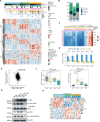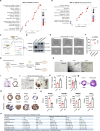Proteogenomic characterization reveals tumorigenesis and progression of lung cancer manifested as subsolid nodules
- PMID: 40069142
- PMCID: PMC11897189
- DOI: 10.1038/s41467-025-57364-x
Proteogenomic characterization reveals tumorigenesis and progression of lung cancer manifested as subsolid nodules
Abstract
Lung adenocarcinoma (LUAD) radiologically displayed as subsolid nodules (SSNs) is prevalent. Nevertheless, the precise clinical management of SSNs necessitates a profound understanding of their tumorigenesis and progression. Here, we analyze 66 LUAD displayed as SSNs covering 3 histological stages including adenocarcinoma in situ (AIS), minimally invasive adenocarcinoma (MIA) and invasive adenocarcinoma (IAC) by incorporating genomics, proteomics, phosphoproteomics and glycoproteomics. Intriguingly, cholesterol metabolism is aberrantly regulated in the preneoplastic AIS stage. Importantly, target ablation of proprotein convertase subtilisin/kexin type 9 (PCSK9) promotes the initiation of LUAD. Furthermore, sustained endoplasmic reticulum stress is demonstrated to be a hallmark and a reliable biomarker of AIS progression to IAC. Consistently, target promotion of ER stress profoundly retards LUAD progression. Our study provides comprehensive proteogenomic landscape of SSNs, sheds lights on the tumorigenesis and progression of SSNs and suggests preventive and therapeutic strategies for LUAD.
© 2025. The Author(s).
Conflict of interest statement
Competing interests: The authors declare no competing interests.
Figures






References
-
- Walter, J. E. et al. New subsolid pulmonary nodules in lung cancer screening: the nelson trial. J. Thorac. Oncol.13, 1410–1414 (2018). - PubMed
-
- Zhang, Y., Fu, F. & Chen, H. Management of ground-glass opacities in the lung cancer spectrum. Ann. Thorac. Surg.110, 1796–1804 (2020). - PubMed
-
- Choi, S., et al. Importance of Lymph Node Evaluation in </=2-cm Pure-Solid Non-Small Cell Lung Cancer. Ann. Thorac. Surg.117, 586–593 (2023). - PubMed
-
- Ye, T. et al. Lung adenocarcinomas manifesting as radiological part-solid nodules define a special clinical subtype. J. Thorac. Oncol.14, 617–627 (2019). - PubMed
MeSH terms
Substances
Grants and funding
LinkOut - more resources
Full Text Sources
Medical
Miscellaneous

